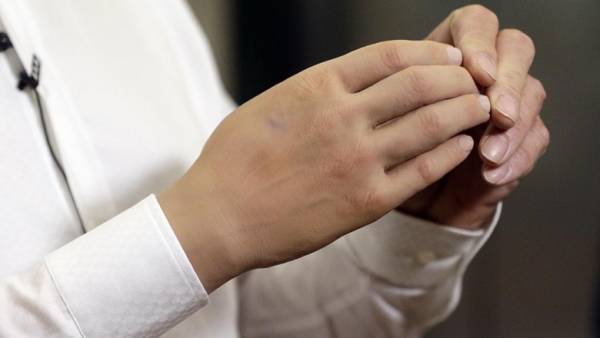Error of the brain: why root amputated limbs and missing teeth
MOSCOW, 18 sen — news, Alfia Enikeeva. Almost 80 percent of amputees to the end of life suffer from phantom pain. Often unpleasant feelings arise in lost hands and feet, sometimes whine even extracted teeth.
Upstairs
RIA Novosti understands how it can hurt what is already there.
Virtual flapping his arms
In September 2014, 14 volunteers, a few years suffer from phantom pain in amputees, was sitting in front of computers in the laboratory of the Technological University of Chalmers (Sweden). Each stroke of their non-existent hands were displayed on the monitors the movements of the virtual hands is a special computer program reads the testimony of electrodes attached to the stumps, and compared them with the patterns characteristic of various movements, and converted into movement on the screen.
News the Mystery of the male brain: what causes the differences
the Mystery of the male brain: what causes the differences
A computer simulation was part of a new method of treatment designed to help patients with phantom pain. Swedish scientists have suggested that if the brain show a virtual hand, the movement of which coincides with the intentions of the patient (how he wanted it to move), pain reduced. And it worked.
After six months of such treatment (12 sessions of virtual therapy), all participants of the experiment felt better. Most of the intensity of pain in amputees has been halved, those who are simultaneously taking medication (anticonvulsants), — at 81 percent. The effect persisted six months after the end of the study.
According to neurophysiologist Vilayanur Ramachandran, after the amputation, areas of the postcentral gyrus of the cerebral cortex related to a lost limb, is not turned off and begin to perceive the signals on the adjacent part of the gyrus. Therefore, amputated the legs and arms may experience pain.To see the Ghost in the mirror
Swedish neuroscientists, ease the lives of 14 volunteers, proceeded from the assumption that after the amputation of a limb related neural network remain without work and, aroused randomly unable to receive signals (including pain) from other neural chains.
Vilayanur Ramachandran, head of the Center for the study of brain and cognitive activities of University of California (USA), also believes that phantom pain arises due to errors in the brain. After people have lost their hands or feet, disturbed mental body scheme is constructed by the brain’s internal model of the human body. As a result, the areas of the postcentral gyrus of the cerebral cortex (that’s where the signals come from different parts of the body) associated with an amputated limb, is not turned off and begin to perceive the signals on the adjacent part of the gyrus. So in lost limbs and pain occur. For example, if Pat the patient on the cheek, he could get sick an amputated arm.
During mirror therapy, a man who has lost his hands, he sees in the mirror the reflection of the intact limb as a continuation of the lost. Attempting to move both hands alleviates phantom pain.
Based on his theory, Ramachandran developed the mirror therapy phantom pain. In front of a man, who lost his hand, put the mirror so that the reflection of the intact limb seemed a continuation of the lost. The patient is then asked to simultaneously move both hands. People saw that both limbs are moving, the brain believed what he saw, and phantom voltage is quickly removed.
The effectiveness of mirror therapy, when man sees a reflection of their existing limb in the place of missing, due to the activity of so-called mirror neurons. In this case, the information that the limb exists in the nervous system overrides the pain impulses, and discomfort are prevented.Maxim Turukanova of the Department of nervous diseases and neurosurgery of the First Moscow state pedagogical University named after I. M. SechenovError brain
That the neurons responsible for the occurrence of phantom pain, sure, and scientists from Oxford University (UK). With amputation of a limb, the brain does not recognize the loss and preserves the chain of nerve cells, responsible for its work.
News Life in pink. How different colors affect our emotions
Life in pink. How different colors affect our emotions
After analyzing maps of brain activity of people suffering from chronic phantom pain, the researchers found that areas of the motor cortex associated with the amputated hand, these patients work the same way as people with intact limbs. In other words, a motor center in the brain continues to believe that the dismembered hand on the spot, and trying to manage it. The result is a conflict with other parts of the brain, understanding that the limbs are no more, and it causes a phantom pain.
A similar point of view, the Swedish neuroscientist max Ortiz-Catalan, who proposed the theory of “stochastic confusion”. Neural networks are left without work after the amputation, they begin to produce nerve impulses in a random order and to receive signals from other nerve chain, including those associated with pain.